HRM Research: Diversity in Positive Action for West Lothian Council
VerifiedAdded on 2019/12/03
|22
|5617
|248
Report
AI Summary
This research proposal critically analyzes the impact of diversity in positive action within the recruitment process of West Lothian Council, a public sector organization. The study aims to investigate the council's practices to promote equal opportunities and a diverse workforce. It begins with a background on HRM and the importance of diversity in modern organizations, referencing relevant legislation like the Equality Act 2010. The proposal outlines specific objectives, including analyzing the concept of diversity in positive action, examining its impact on recruitment, and identifying best practices. A literature review explores the definition of positive action, its benefits, and the barriers to its implementation, drawing on various academic sources. The research will examine existing practices within the industry, particularly focusing on the recruitment process and how organizations can encourage applicants from diverse backgrounds. The study intends to provide recommendations for West Lothian Council, based on the findings, to enhance its diversity and inclusion efforts.

Paraphrase This Document
Need a fresh take? Get an instant paraphrase of this document with our AI Paraphraser
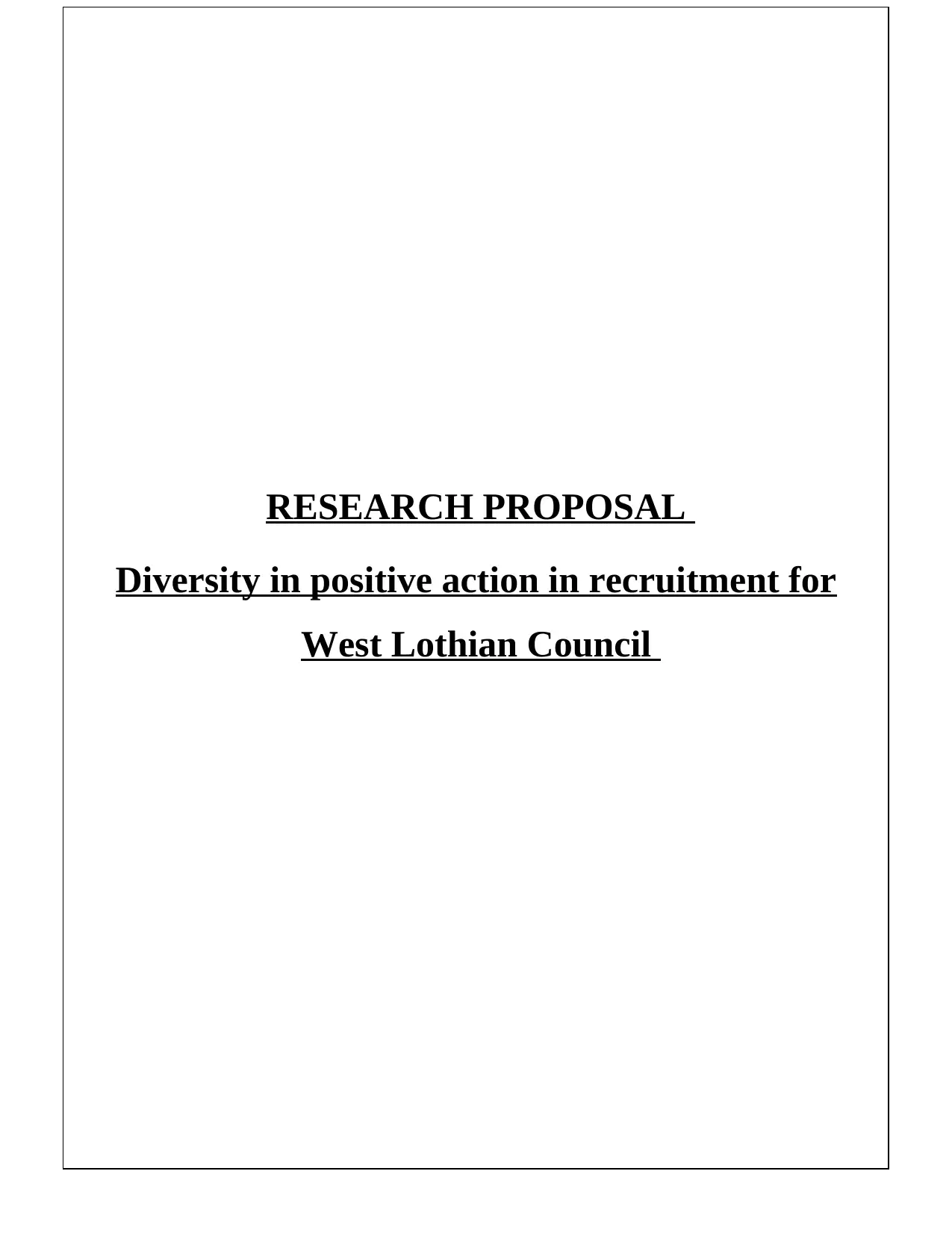
RESEARCH PROPOSAL
Diversity in positive action in recruitment for
West Lothian Council
Diversity in positive action in recruitment for
West Lothian Council

2
⊘ This is a preview!⊘
Do you want full access?
Subscribe today to unlock all pages.

Trusted by 1+ million students worldwide
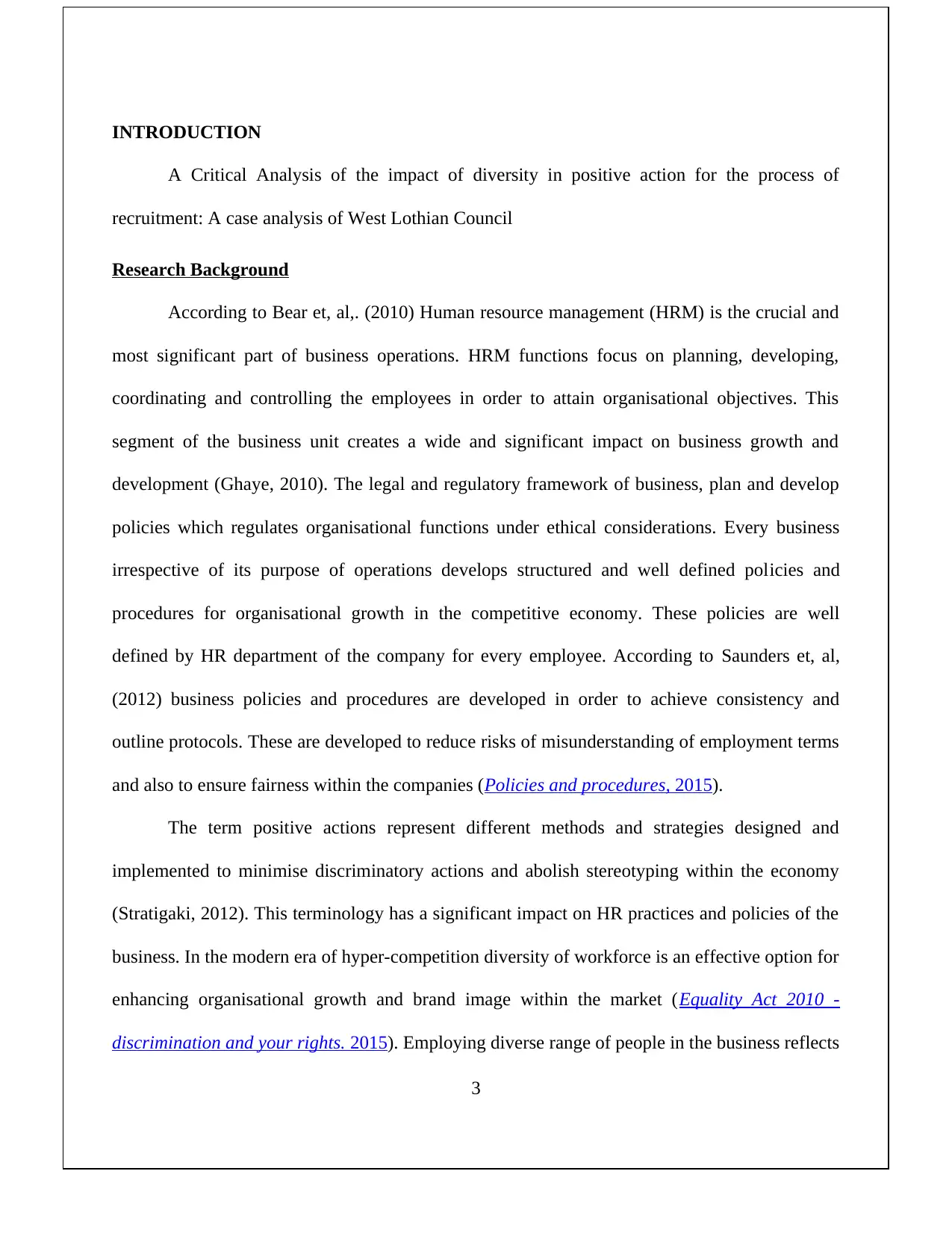
INTRODUCTION
A Critical Analysis of the impact of diversity in positive action for the process of
recruitment: A case analysis of West Lothian Council
Research Background
According to Bear et, al,. (2010) Human resource management (HRM) is the crucial and
most significant part of business operations. HRM functions focus on planning, developing,
coordinating and controlling the employees in order to attain organisational objectives. This
segment of the business unit creates a wide and significant impact on business growth and
development (Ghaye, 2010). The legal and regulatory framework of business, plan and develop
policies which regulates organisational functions under ethical considerations. Every business
irrespective of its purpose of operations develops structured and well defined policies and
procedures for organisational growth in the competitive economy. These policies are well
defined by HR department of the company for every employee. According to Saunders et, al,
(2012) business policies and procedures are developed in order to achieve consistency and
outline protocols. These are developed to reduce risks of misunderstanding of employment terms
and also to ensure fairness within the companies (Policies and procedures, 2015).
The term positive actions represent different methods and strategies designed and
implemented to minimise discriminatory actions and abolish stereotyping within the economy
(Stratigaki, 2012). This terminology has a significant impact on HR practices and policies of the
business. In the modern era of hyper-competition diversity of workforce is an effective option for
enhancing organisational growth and brand image within the market (Equality Act 2010 -
discrimination and your rights. 2015). Employing diverse range of people in the business reflects
3
A Critical Analysis of the impact of diversity in positive action for the process of
recruitment: A case analysis of West Lothian Council
Research Background
According to Bear et, al,. (2010) Human resource management (HRM) is the crucial and
most significant part of business operations. HRM functions focus on planning, developing,
coordinating and controlling the employees in order to attain organisational objectives. This
segment of the business unit creates a wide and significant impact on business growth and
development (Ghaye, 2010). The legal and regulatory framework of business, plan and develop
policies which regulates organisational functions under ethical considerations. Every business
irrespective of its purpose of operations develops structured and well defined policies and
procedures for organisational growth in the competitive economy. These policies are well
defined by HR department of the company for every employee. According to Saunders et, al,
(2012) business policies and procedures are developed in order to achieve consistency and
outline protocols. These are developed to reduce risks of misunderstanding of employment terms
and also to ensure fairness within the companies (Policies and procedures, 2015).
The term positive actions represent different methods and strategies designed and
implemented to minimise discriminatory actions and abolish stereotyping within the economy
(Stratigaki, 2012). This terminology has a significant impact on HR practices and policies of the
business. In the modern era of hyper-competition diversity of workforce is an effective option for
enhancing organisational growth and brand image within the market (Equality Act 2010 -
discrimination and your rights. 2015). Employing diverse range of people in the business reflects
3
Paraphrase This Document
Need a fresh take? Get an instant paraphrase of this document with our AI Paraphraser
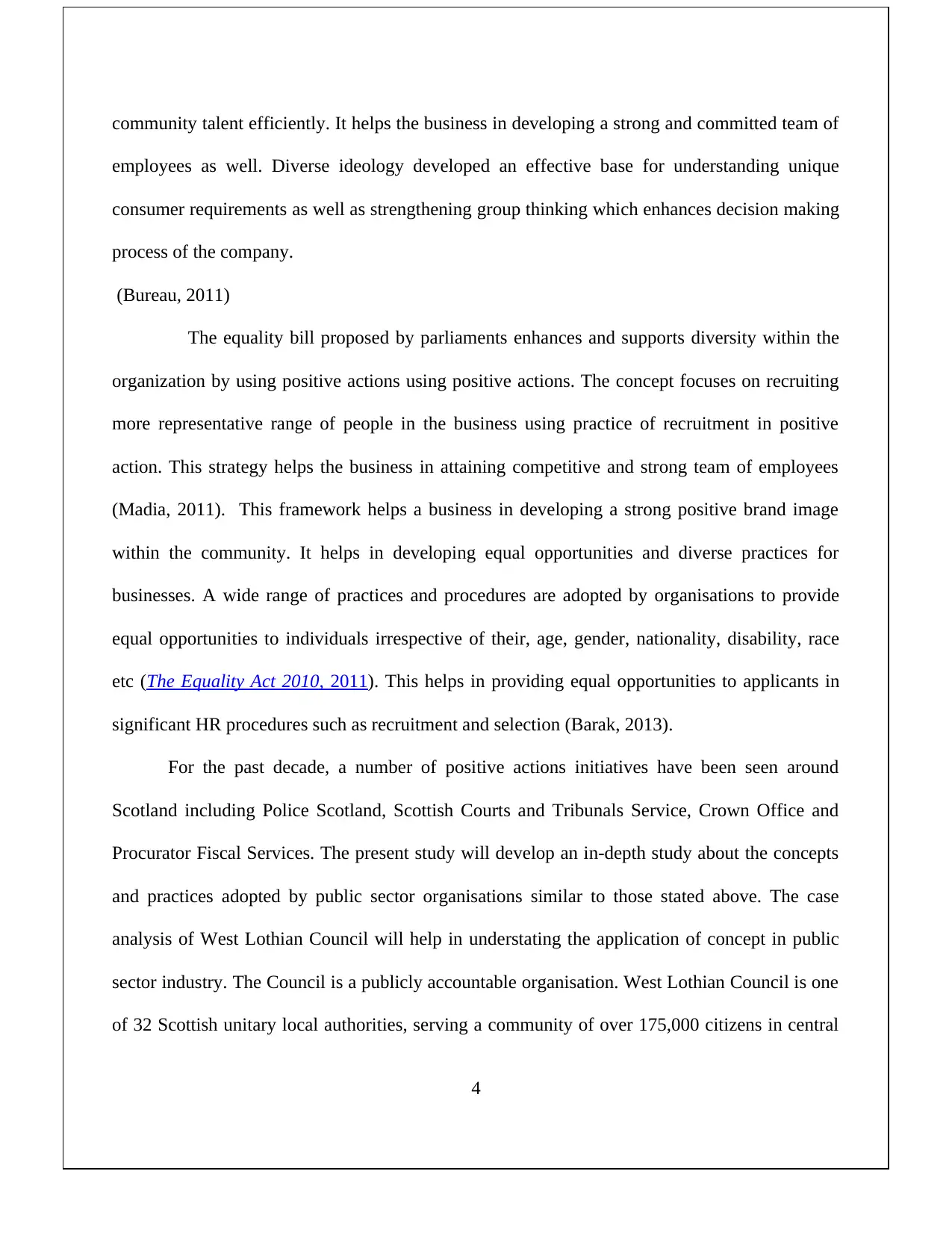
community talent efficiently. It helps the business in developing a strong and committed team of
employees as well. Diverse ideology developed an effective base for understanding unique
consumer requirements as well as strengthening group thinking which enhances decision making
process of the company.
(Bureau, 2011)
The equality bill proposed by parliaments enhances and supports diversity within the
organization by using positive actions using positive actions. The concept focuses on recruiting
more representative range of people in the business using practice of recruitment in positive
action. This strategy helps the business in attaining competitive and strong team of employees
(Madia, 2011). This framework helps a business in developing a strong positive brand image
within the community. It helps in developing equal opportunities and diverse practices for
businesses. A wide range of practices and procedures are adopted by organisations to provide
equal opportunities to individuals irrespective of their, age, gender, nationality, disability, race
etc (The Equality Act 2010, 2011). This helps in providing equal opportunities to applicants in
significant HR procedures such as recruitment and selection (Barak, 2013).
For the past decade, a number of positive actions initiatives have been seen around
Scotland including Police Scotland, Scottish Courts and Tribunals Service, Crown Office and
Procurator Fiscal Services. The present study will develop an in-depth study about the concepts
and practices adopted by public sector organisations similar to those stated above. The case
analysis of West Lothian Council will help in understating the application of concept in public
sector industry. The Council is a publicly accountable organisation. West Lothian Council is one
of 32 Scottish unitary local authorities, serving a community of over 175,000 citizens in central
4
employees as well. Diverse ideology developed an effective base for understanding unique
consumer requirements as well as strengthening group thinking which enhances decision making
process of the company.
(Bureau, 2011)
The equality bill proposed by parliaments enhances and supports diversity within the
organization by using positive actions using positive actions. The concept focuses on recruiting
more representative range of people in the business using practice of recruitment in positive
action. This strategy helps the business in attaining competitive and strong team of employees
(Madia, 2011). This framework helps a business in developing a strong positive brand image
within the community. It helps in developing equal opportunities and diverse practices for
businesses. A wide range of practices and procedures are adopted by organisations to provide
equal opportunities to individuals irrespective of their, age, gender, nationality, disability, race
etc (The Equality Act 2010, 2011). This helps in providing equal opportunities to applicants in
significant HR procedures such as recruitment and selection (Barak, 2013).
For the past decade, a number of positive actions initiatives have been seen around
Scotland including Police Scotland, Scottish Courts and Tribunals Service, Crown Office and
Procurator Fiscal Services. The present study will develop an in-depth study about the concepts
and practices adopted by public sector organisations similar to those stated above. The case
analysis of West Lothian Council will help in understating the application of concept in public
sector industry. The Council is a publicly accountable organisation. West Lothian Council is one
of 32 Scottish unitary local authorities, serving a community of over 175,000 citizens in central
4
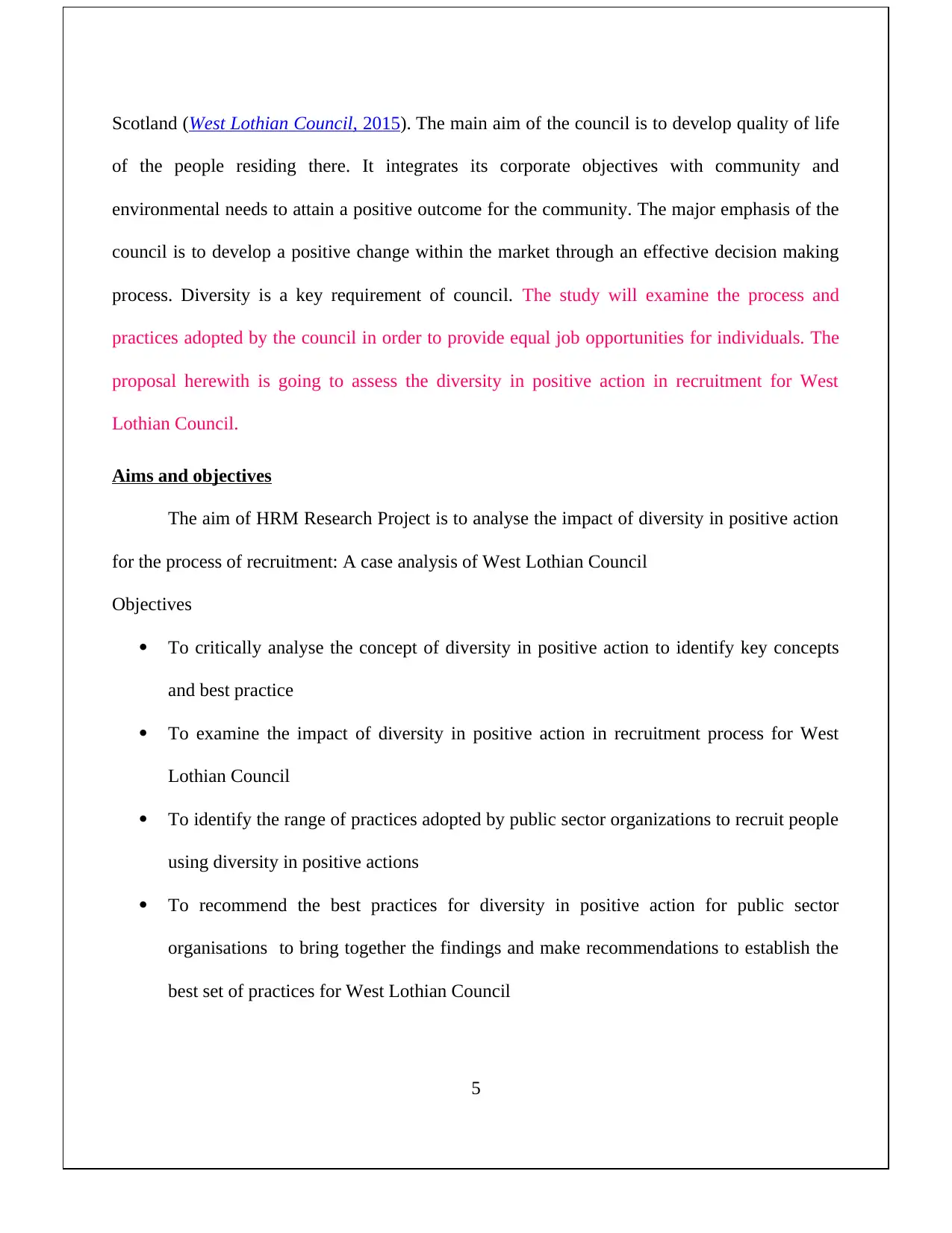
Scotland (West Lothian Council, 2015). The main aim of the council is to develop quality of life
of the people residing there. It integrates its corporate objectives with community and
environmental needs to attain a positive outcome for the community. The major emphasis of the
council is to develop a positive change within the market through an effective decision making
process. Diversity is a key requirement of council. The study will examine the process and
practices adopted by the council in order to provide equal job opportunities for individuals. The
proposal herewith is going to assess the diversity in positive action in recruitment for West
Lothian Council.
Aims and objectives
The aim of HRM Research Project is to analyse the impact of diversity in positive action
for the process of recruitment: A case analysis of West Lothian Council
Objectives
To critically analyse the concept of diversity in positive action to identify key concepts
and best practice
To examine the impact of diversity in positive action in recruitment process for West
Lothian Council
To identify the range of practices adopted by public sector organizations to recruit people
using diversity in positive actions
To recommend the best practices for diversity in positive action for public sector
organisations to bring together the findings and make recommendations to establish the
best set of practices for West Lothian Council
5
of the people residing there. It integrates its corporate objectives with community and
environmental needs to attain a positive outcome for the community. The major emphasis of the
council is to develop a positive change within the market through an effective decision making
process. Diversity is a key requirement of council. The study will examine the process and
practices adopted by the council in order to provide equal job opportunities for individuals. The
proposal herewith is going to assess the diversity in positive action in recruitment for West
Lothian Council.
Aims and objectives
The aim of HRM Research Project is to analyse the impact of diversity in positive action
for the process of recruitment: A case analysis of West Lothian Council
Objectives
To critically analyse the concept of diversity in positive action to identify key concepts
and best practice
To examine the impact of diversity in positive action in recruitment process for West
Lothian Council
To identify the range of practices adopted by public sector organizations to recruit people
using diversity in positive actions
To recommend the best practices for diversity in positive action for public sector
organisations to bring together the findings and make recommendations to establish the
best set of practices for West Lothian Council
5
⊘ This is a preview!⊘
Do you want full access?
Subscribe today to unlock all pages.

Trusted by 1+ million students worldwide
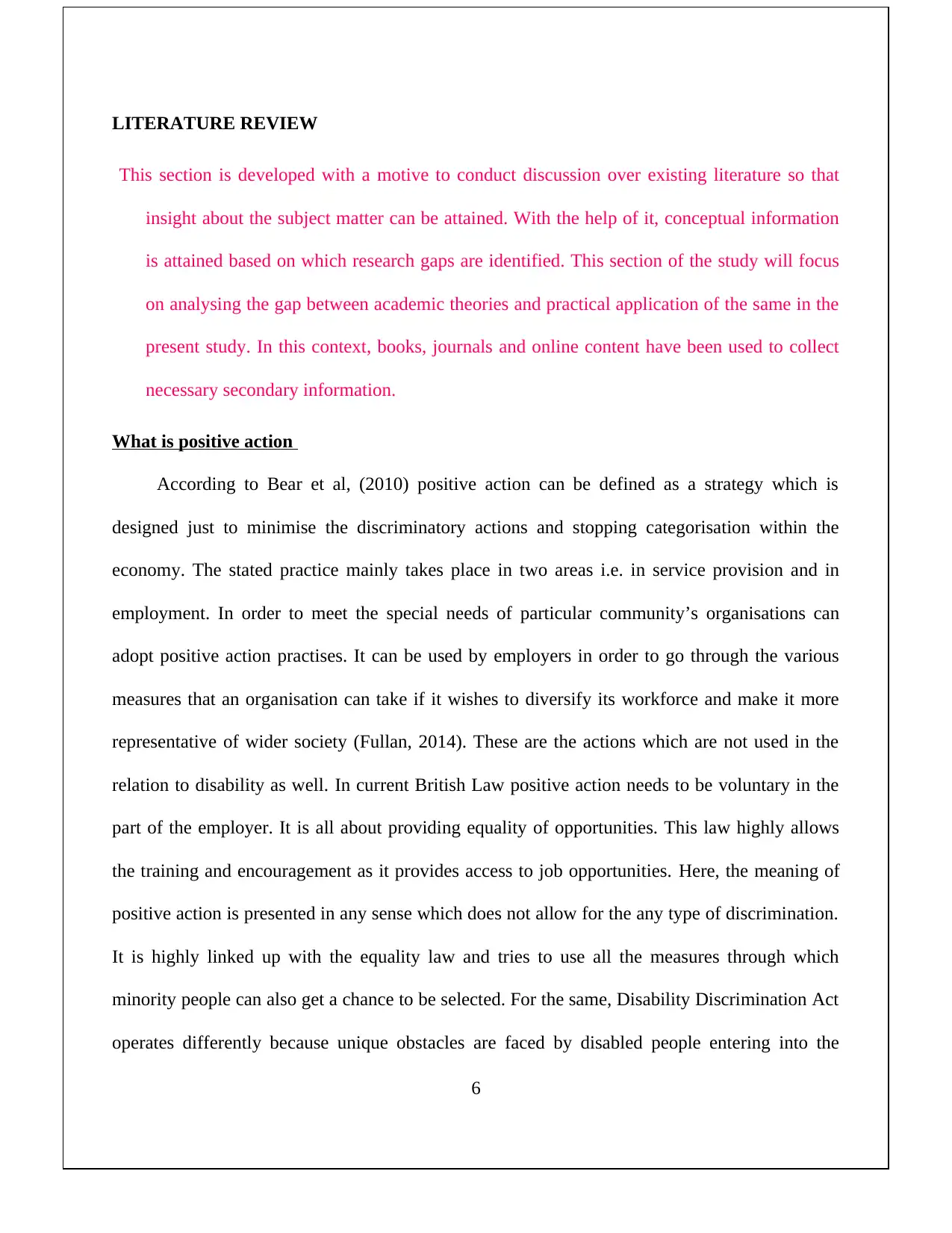
LITERATURE REVIEW
This section is developed with a motive to conduct discussion over existing literature so that
insight about the subject matter can be attained. With the help of it, conceptual information
is attained based on which research gaps are identified. This section of the study will focus
on analysing the gap between academic theories and practical application of the same in the
present study. In this context, books, journals and online content have been used to collect
necessary secondary information.
What is positive action
According to Bear et al, (2010) positive action can be defined as a strategy which is
designed just to minimise the discriminatory actions and stopping categorisation within the
economy. The stated practice mainly takes place in two areas i.e. in service provision and in
employment. In order to meet the special needs of particular community’s organisations can
adopt positive action practises. It can be used by employers in order to go through the various
measures that an organisation can take if it wishes to diversify its workforce and make it more
representative of wider society (Fullan, 2014). These are the actions which are not used in the
relation to disability as well. In current British Law positive action needs to be voluntary in the
part of the employer. It is all about providing equality of opportunities. This law highly allows
the training and encouragement as it provides access to job opportunities. Here, the meaning of
positive action is presented in any sense which does not allow for the any type of discrimination.
It is highly linked up with the equality law and tries to use all the measures through which
minority people can also get a chance to be selected. For the same, Disability Discrimination Act
operates differently because unique obstacles are faced by disabled people entering into the
6
This section is developed with a motive to conduct discussion over existing literature so that
insight about the subject matter can be attained. With the help of it, conceptual information
is attained based on which research gaps are identified. This section of the study will focus
on analysing the gap between academic theories and practical application of the same in the
present study. In this context, books, journals and online content have been used to collect
necessary secondary information.
What is positive action
According to Bear et al, (2010) positive action can be defined as a strategy which is
designed just to minimise the discriminatory actions and stopping categorisation within the
economy. The stated practice mainly takes place in two areas i.e. in service provision and in
employment. In order to meet the special needs of particular community’s organisations can
adopt positive action practises. It can be used by employers in order to go through the various
measures that an organisation can take if it wishes to diversify its workforce and make it more
representative of wider society (Fullan, 2014). These are the actions which are not used in the
relation to disability as well. In current British Law positive action needs to be voluntary in the
part of the employer. It is all about providing equality of opportunities. This law highly allows
the training and encouragement as it provides access to job opportunities. Here, the meaning of
positive action is presented in any sense which does not allow for the any type of discrimination.
It is highly linked up with the equality law and tries to use all the measures through which
minority people can also get a chance to be selected. For the same, Disability Discrimination Act
operates differently because unique obstacles are faced by disabled people entering into the
6
Paraphrase This Document
Need a fresh take? Get an instant paraphrase of this document with our AI Paraphraser
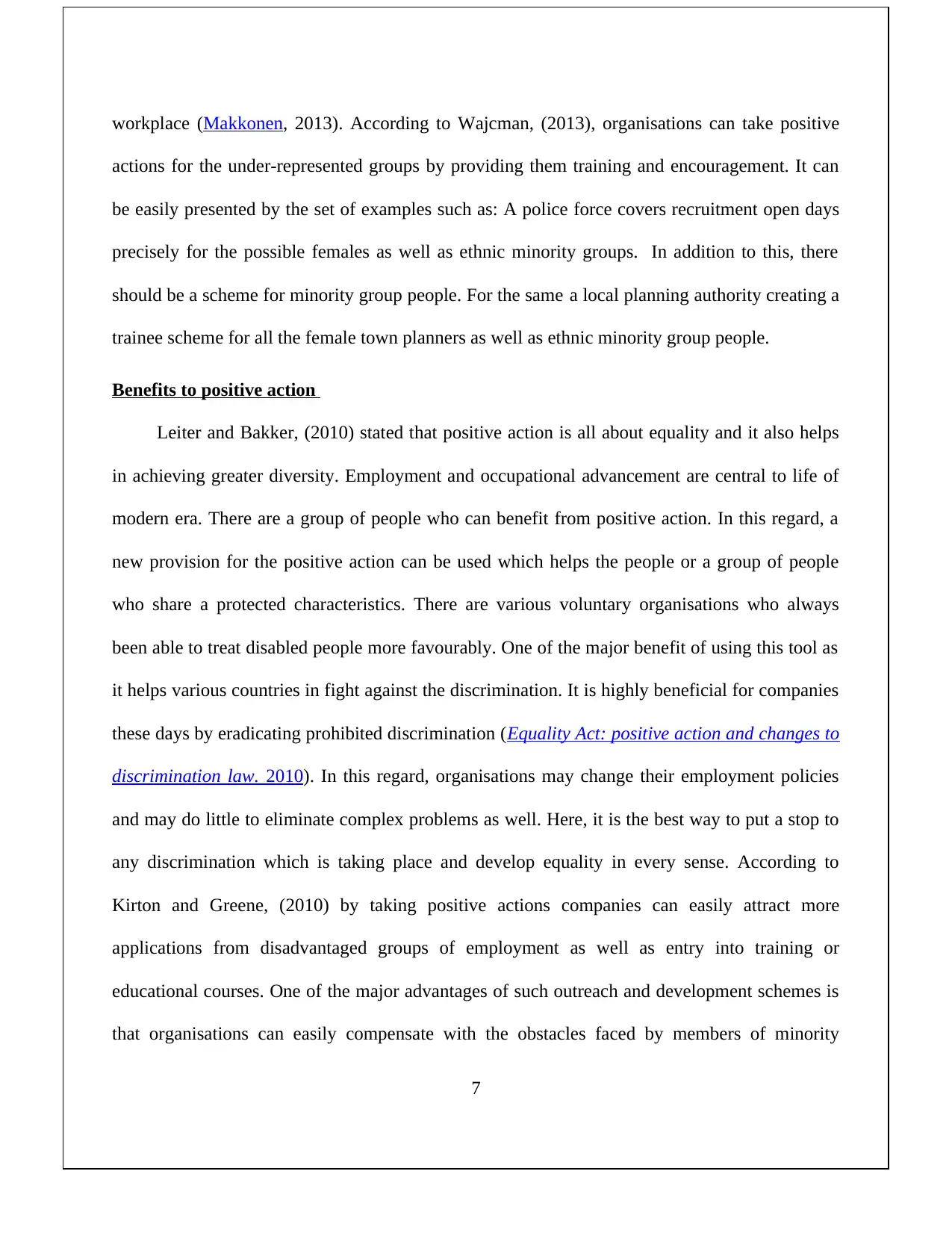
workplace (Makkonen, 2013). According to Wajcman, (2013), organisations can take positive
actions for the under-represented groups by providing them training and encouragement. It can
be easily presented by the set of examples such as: A police force covers recruitment open days
precisely for the possible females as well as ethnic minority groups. In addition to this, there
should be a scheme for minority group people. For the same a local planning authority creating a
trainee scheme for all the female town planners as well as ethnic minority group people.
Benefits to positive action
Leiter and Bakker, (2010) stated that positive action is all about equality and it also helps
in achieving greater diversity. Employment and occupational advancement are central to life of
modern era. There are a group of people who can benefit from positive action. In this regard, a
new provision for the positive action can be used which helps the people or a group of people
who share a protected characteristics. There are various voluntary organisations who always
been able to treat disabled people more favourably. One of the major benefit of using this tool as
it helps various countries in fight against the discrimination. It is highly beneficial for companies
these days by eradicating prohibited discrimination (Equality Act: positive action and changes to
discrimination law. 2010). In this regard, organisations may change their employment policies
and may do little to eliminate complex problems as well. Here, it is the best way to put a stop to
any discrimination which is taking place and develop equality in every sense. According to
Kirton and Greene, (2010) by taking positive actions companies can easily attract more
applications from disadvantaged groups of employment as well as entry into training or
educational courses. One of the major advantages of such outreach and development schemes is
that organisations can easily compensate with the obstacles faced by members of minority
7
actions for the under-represented groups by providing them training and encouragement. It can
be easily presented by the set of examples such as: A police force covers recruitment open days
precisely for the possible females as well as ethnic minority groups. In addition to this, there
should be a scheme for minority group people. For the same a local planning authority creating a
trainee scheme for all the female town planners as well as ethnic minority group people.
Benefits to positive action
Leiter and Bakker, (2010) stated that positive action is all about equality and it also helps
in achieving greater diversity. Employment and occupational advancement are central to life of
modern era. There are a group of people who can benefit from positive action. In this regard, a
new provision for the positive action can be used which helps the people or a group of people
who share a protected characteristics. There are various voluntary organisations who always
been able to treat disabled people more favourably. One of the major benefit of using this tool as
it helps various countries in fight against the discrimination. It is highly beneficial for companies
these days by eradicating prohibited discrimination (Equality Act: positive action and changes to
discrimination law. 2010). In this regard, organisations may change their employment policies
and may do little to eliminate complex problems as well. Here, it is the best way to put a stop to
any discrimination which is taking place and develop equality in every sense. According to
Kirton and Greene, (2010) by taking positive actions companies can easily attract more
applications from disadvantaged groups of employment as well as entry into training or
educational courses. One of the major advantages of such outreach and development schemes is
that organisations can easily compensate with the obstacles faced by members of minority
7
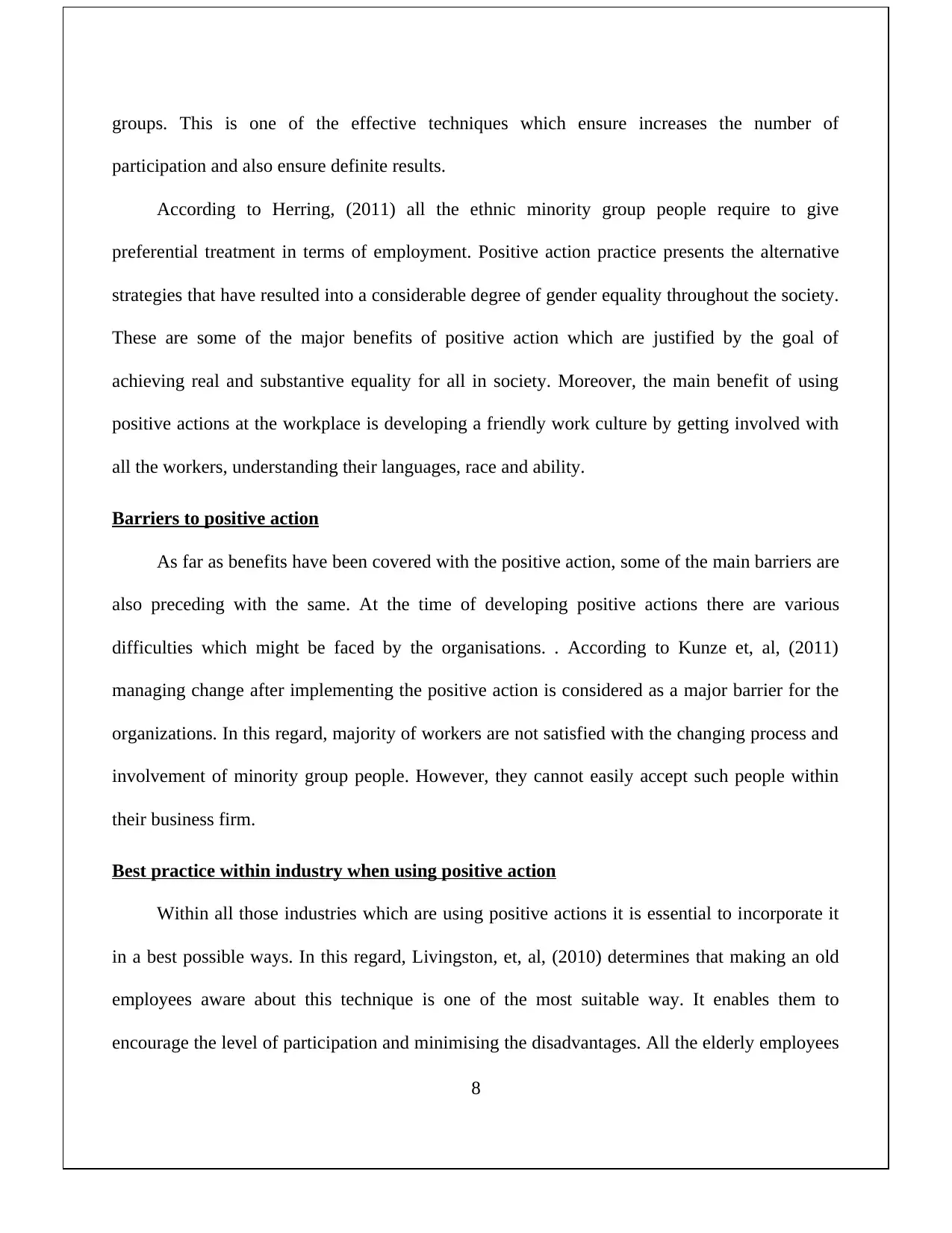
groups. This is one of the effective techniques which ensure increases the number of
participation and also ensure definite results.
According to Herring, (2011) all the ethnic minority group people require to give
preferential treatment in terms of employment. Positive action practice presents the alternative
strategies that have resulted into a considerable degree of gender equality throughout the society.
These are some of the major benefits of positive action which are justified by the goal of
achieving real and substantive equality for all in society. Moreover, the main benefit of using
positive actions at the workplace is developing a friendly work culture by getting involved with
all the workers, understanding their languages, race and ability.
Barriers to positive action
As far as benefits have been covered with the positive action, some of the main barriers are
also preceding with the same. At the time of developing positive actions there are various
difficulties which might be faced by the organisations. . According to Kunze et, al, (2011)
managing change after implementing the positive action is considered as a major barrier for the
organizations. In this regard, majority of workers are not satisfied with the changing process and
involvement of minority group people. However, they cannot easily accept such people within
their business firm.
Best practice within industry when using positive action
Within all those industries which are using positive actions it is essential to incorporate it
in a best possible ways. In this regard, Livingston, et, al, (2010) determines that making an old
employees aware about this technique is one of the most suitable way. It enables them to
encourage the level of participation and minimising the disadvantages. All the elderly employees
8
participation and also ensure definite results.
According to Herring, (2011) all the ethnic minority group people require to give
preferential treatment in terms of employment. Positive action practice presents the alternative
strategies that have resulted into a considerable degree of gender equality throughout the society.
These are some of the major benefits of positive action which are justified by the goal of
achieving real and substantive equality for all in society. Moreover, the main benefit of using
positive actions at the workplace is developing a friendly work culture by getting involved with
all the workers, understanding their languages, race and ability.
Barriers to positive action
As far as benefits have been covered with the positive action, some of the main barriers are
also preceding with the same. At the time of developing positive actions there are various
difficulties which might be faced by the organisations. . According to Kunze et, al, (2011)
managing change after implementing the positive action is considered as a major barrier for the
organizations. In this regard, majority of workers are not satisfied with the changing process and
involvement of minority group people. However, they cannot easily accept such people within
their business firm.
Best practice within industry when using positive action
Within all those industries which are using positive actions it is essential to incorporate it
in a best possible ways. In this regard, Livingston, et, al, (2010) determines that making an old
employees aware about this technique is one of the most suitable way. It enables them to
encourage the level of participation and minimising the disadvantages. All the elderly employees
8
⊘ This is a preview!⊘
Do you want full access?
Subscribe today to unlock all pages.

Trusted by 1+ million students worldwide
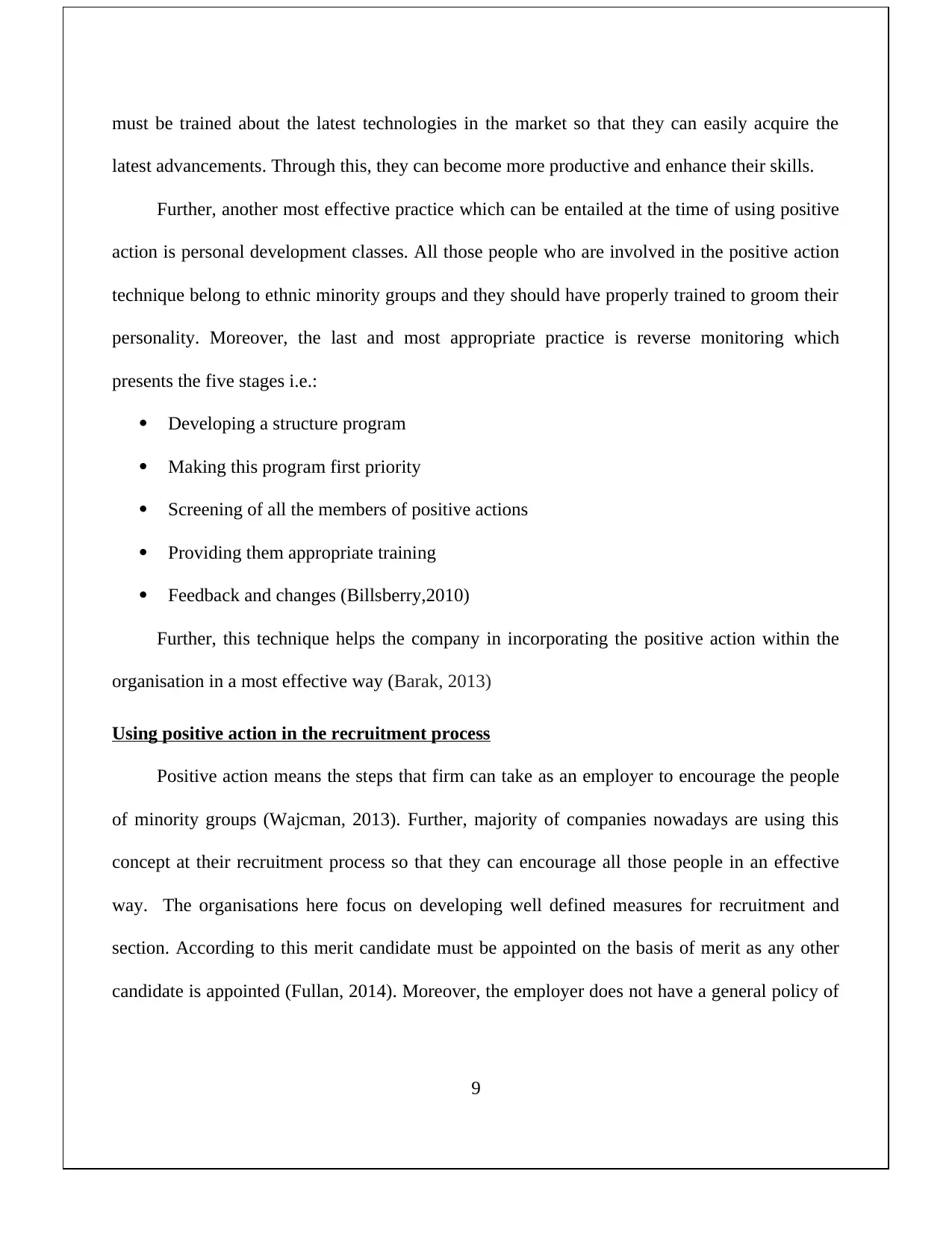
must be trained about the latest technologies in the market so that they can easily acquire the
latest advancements. Through this, they can become more productive and enhance their skills.
Further, another most effective practice which can be entailed at the time of using positive
action is personal development classes. All those people who are involved in the positive action
technique belong to ethnic minority groups and they should have properly trained to groom their
personality. Moreover, the last and most appropriate practice is reverse monitoring which
presents the five stages i.e.:
Developing a structure program
Making this program first priority
Screening of all the members of positive actions
Providing them appropriate training
Feedback and changes (Billsberry,2010)
Further, this technique helps the company in incorporating the positive action within the
organisation in a most effective way (Barak, 2013)
Using positive action in the recruitment process
Positive action means the steps that firm can take as an employer to encourage the people
of minority groups (Wajcman, 2013). Further, majority of companies nowadays are using this
concept at their recruitment process so that they can encourage all those people in an effective
way. The organisations here focus on developing well defined measures for recruitment and
section. According to this merit candidate must be appointed on the basis of merit as any other
candidate is appointed (Fullan, 2014). Moreover, the employer does not have a general policy of
9
latest advancements. Through this, they can become more productive and enhance their skills.
Further, another most effective practice which can be entailed at the time of using positive
action is personal development classes. All those people who are involved in the positive action
technique belong to ethnic minority groups and they should have properly trained to groom their
personality. Moreover, the last and most appropriate practice is reverse monitoring which
presents the five stages i.e.:
Developing a structure program
Making this program first priority
Screening of all the members of positive actions
Providing them appropriate training
Feedback and changes (Billsberry,2010)
Further, this technique helps the company in incorporating the positive action within the
organisation in a most effective way (Barak, 2013)
Using positive action in the recruitment process
Positive action means the steps that firm can take as an employer to encourage the people
of minority groups (Wajcman, 2013). Further, majority of companies nowadays are using this
concept at their recruitment process so that they can encourage all those people in an effective
way. The organisations here focus on developing well defined measures for recruitment and
section. According to this merit candidate must be appointed on the basis of merit as any other
candidate is appointed (Fullan, 2014). Moreover, the employer does not have a general policy of
9
Paraphrase This Document
Need a fresh take? Get an instant paraphrase of this document with our AI Paraphraser
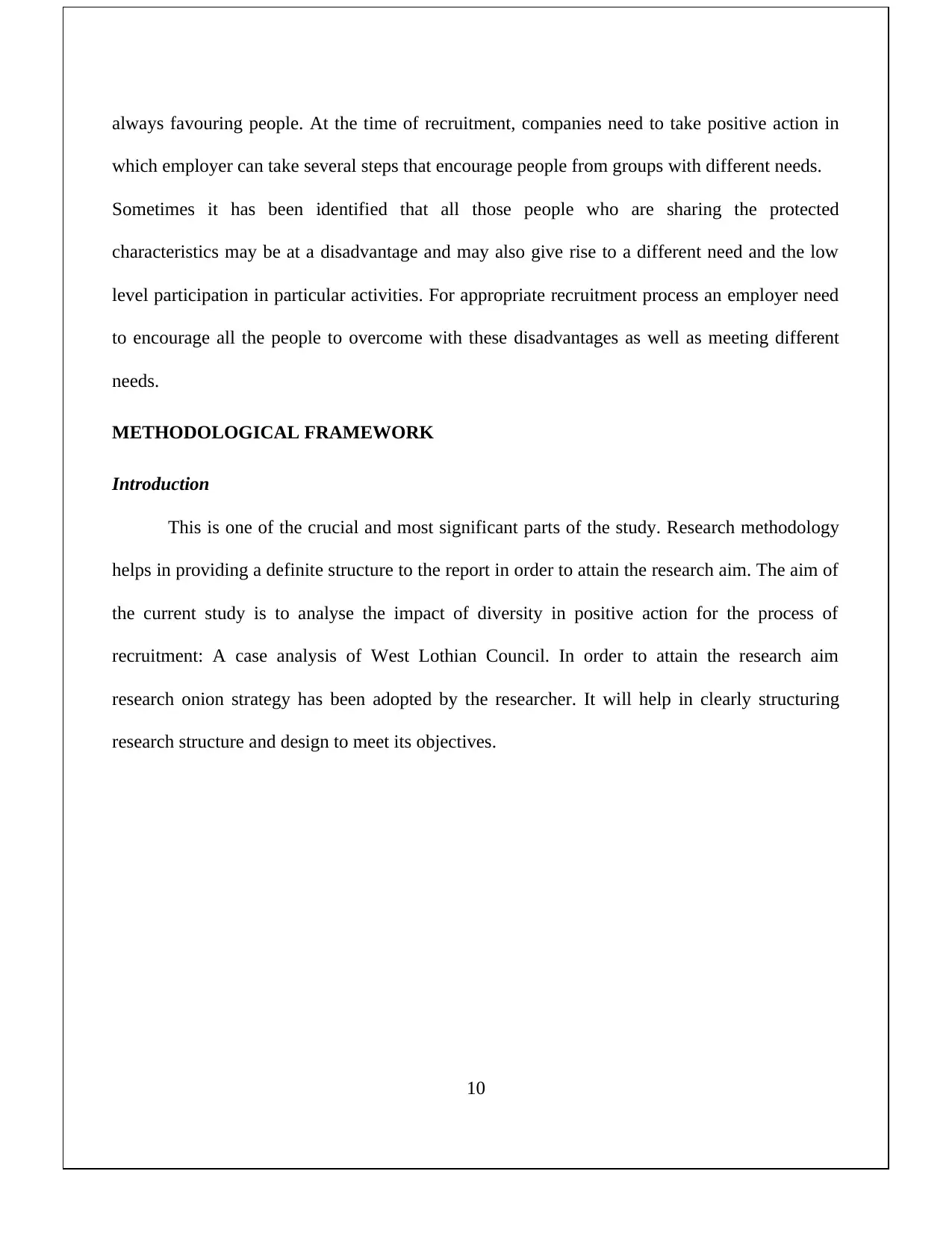
always favouring people. At the time of recruitment, companies need to take positive action in
which employer can take several steps that encourage people from groups with different needs.
Sometimes it has been identified that all those people who are sharing the protected
characteristics may be at a disadvantage and may also give rise to a different need and the low
level participation in particular activities. For appropriate recruitment process an employer need
to encourage all the people to overcome with these disadvantages as well as meeting different
needs.
METHODOLOGICAL FRAMEWORK
Introduction
This is one of the crucial and most significant parts of the study. Research methodology
helps in providing a definite structure to the report in order to attain the research aim. The aim of
the current study is to analyse the impact of diversity in positive action for the process of
recruitment: A case analysis of West Lothian Council. In order to attain the research aim
research onion strategy has been adopted by the researcher. It will help in clearly structuring
research structure and design to meet its objectives.
10
which employer can take several steps that encourage people from groups with different needs.
Sometimes it has been identified that all those people who are sharing the protected
characteristics may be at a disadvantage and may also give rise to a different need and the low
level participation in particular activities. For appropriate recruitment process an employer need
to encourage all the people to overcome with these disadvantages as well as meeting different
needs.
METHODOLOGICAL FRAMEWORK
Introduction
This is one of the crucial and most significant parts of the study. Research methodology
helps in providing a definite structure to the report in order to attain the research aim. The aim of
the current study is to analyse the impact of diversity in positive action for the process of
recruitment: A case analysis of West Lothian Council. In order to attain the research aim
research onion strategy has been adopted by the researcher. It will help in clearly structuring
research structure and design to meet its objectives.
10
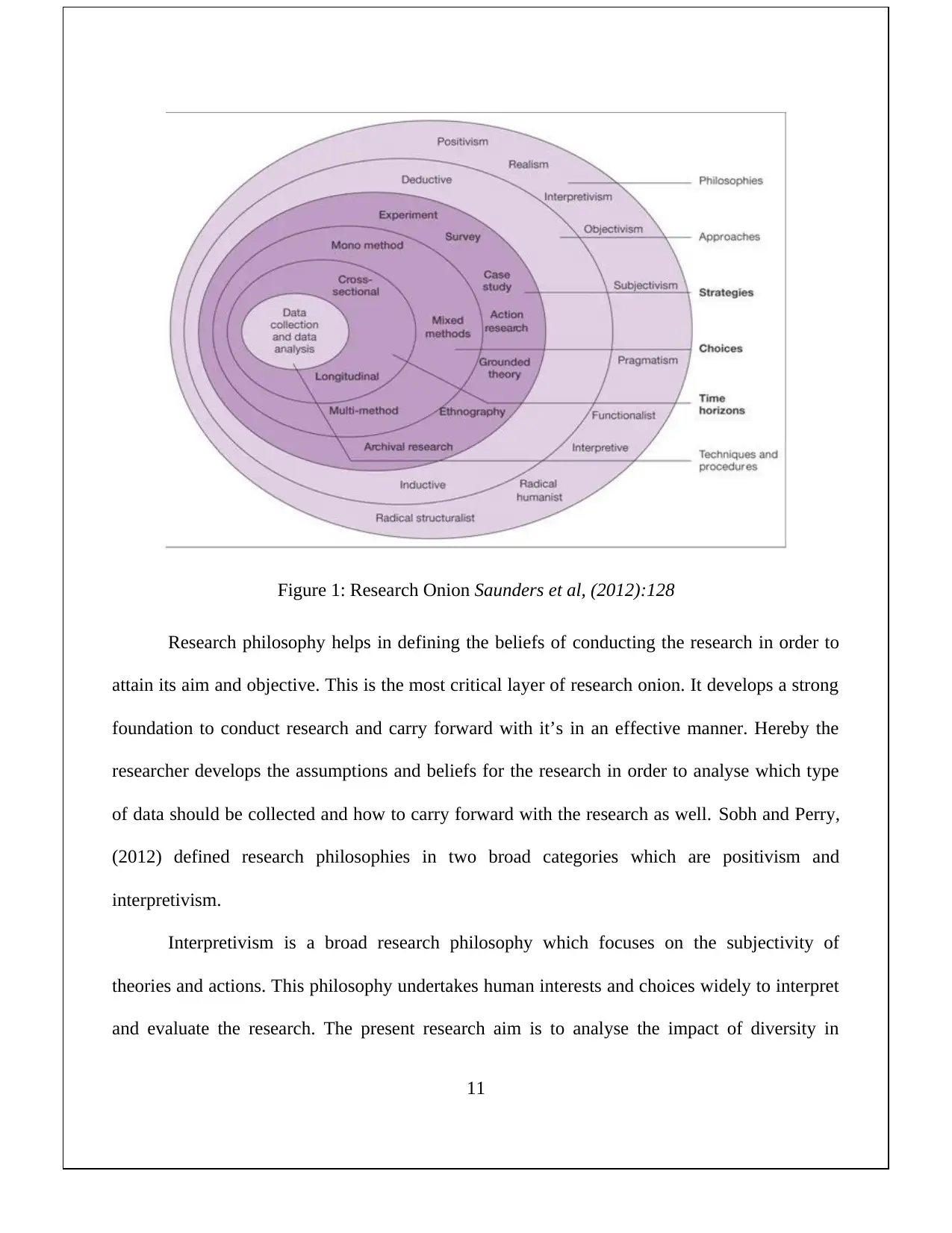
Figure 1: Research Onion Saunders et al, (2012):128
Research philosophy helps in defining the beliefs of conducting the research in order to
attain its aim and objective. This is the most critical layer of research onion. It develops a strong
foundation to conduct research and carry forward with it’s in an effective manner. Hereby the
researcher develops the assumptions and beliefs for the research in order to analyse which type
of data should be collected and how to carry forward with the research as well. Sobh and Perry,
(2012) defined research philosophies in two broad categories which are positivism and
interpretivism.
Interpretivism is a broad research philosophy which focuses on the subjectivity of
theories and actions. This philosophy undertakes human interests and choices widely to interpret
and evaluate the research. The present research aim is to analyse the impact of diversity in
11
Research philosophy helps in defining the beliefs of conducting the research in order to
attain its aim and objective. This is the most critical layer of research onion. It develops a strong
foundation to conduct research and carry forward with it’s in an effective manner. Hereby the
researcher develops the assumptions and beliefs for the research in order to analyse which type
of data should be collected and how to carry forward with the research as well. Sobh and Perry,
(2012) defined research philosophies in two broad categories which are positivism and
interpretivism.
Interpretivism is a broad research philosophy which focuses on the subjectivity of
theories and actions. This philosophy undertakes human interests and choices widely to interpret
and evaluate the research. The present research aim is to analyse the impact of diversity in
11
⊘ This is a preview!⊘
Do you want full access?
Subscribe today to unlock all pages.

Trusted by 1+ million students worldwide
1 out of 22
Related Documents
Your All-in-One AI-Powered Toolkit for Academic Success.
+13062052269
info@desklib.com
Available 24*7 on WhatsApp / Email
![[object Object]](/_next/static/media/star-bottom.7253800d.svg)
Unlock your academic potential
Copyright © 2020–2025 A2Z Services. All Rights Reserved. Developed and managed by ZUCOL.





